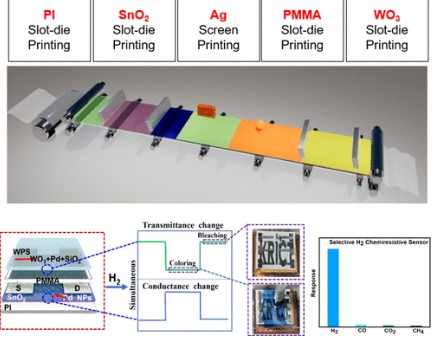Large-Area Printed Oxide Film Sensors Enabling Ultrasensitive and Dual Electrical/Colorimetric Detection of Hydrogen at Room Temperature
- 저자
- Henok Getachew Girma, Ka Yeon Ryu, Xiaowu Tang, Gi-Seong Ryu, Rixuan Wang, Yejin Kim, Jae Ook Choi, Hye Min Lee, Seungju Jeon, Seo-Hyun Jung, Jong Mok Park, Yu Jin Jung, Jin Young Kim, Do-Hoon Hwang, Yong-Young Noh*, Bogyu Lim*, Hoyoul Kong*, Se Hyun Kim*
- 저널명
- ACS sensors, 8, 8, 3004-3013 (2023)
- 년도
- 2023
- Link
- https://pubs.acs.org/doi/10.1021/acssensors.3c00469 550회 연결
[Abstract]
Commercial hydrogen (H2) sensors operate at high temperatures, which increases power consumption and poses a safety risk owing to the flammable nature of H2. Here, a polymer-noble metal-metal oxide film is fabricated using the spin-coating and printing methods to realize a highly sensitive, low-voltage operation, wide-operating-concentration, and near-monoselective H2 sensor at room temperature. The H2 sensors with an optimized thickness of Pd nanoparticles and SnO2 showed an extremely high response of 16,623 with a response time of 6 s and a recovery time of 5 s at room temperature and 2% H2. At the same time, printed flexible sensors demonstrate excellent sensitivity, with a response of 2300 at 2% H2. The excellent sensing performance at room temperature is due to the optimal SnO2 thickness, corresponding to the Debye length and the oxygen and H2 spillover caused by the optimized coverage of the Pd catalyst. Furthermore, multistructures of WO3 and SnO2 films are used to fabricate a new type of dual-signal sensor, which demonstrated simultaneous conductance and transmittance, i.e., color change. This work provides an effective strategy to develop robust, flexible, transparent, and long-lasting H2 sensors through large-area printing processes based on polymer-metal-metal oxide nanostructures.
- 이전글Reduction of Hole Carriers by van der Waals Contact for Enhanced Photoluminescence Quantum Yield in Two-Dimensional Tin Halide Perovskite 24.12.12
- 다음글Tuning of the Stretchability and Charge Transport of Bis-Diketopyrrolopyrrole and Carbazole-Based Thermoplastic Soft Semiconductors by Modulating Soft Segment Contents 24.12.12
